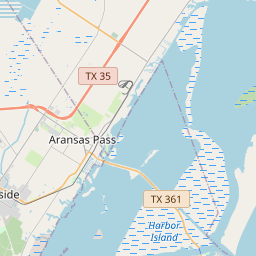First United Methodist Church of Aransas Pass
Historical marker location:






Efforts to create a regional shipping center and port in this vicinity began in the middle 19th century. By 1890, plans were well underway to dig a ship channel and develop Aransas Harbor City. Residents of Aransas Harbor (now Aransas Pass) used a structure known as the Dwyer and Drummond Pavilion for meetings and events. On February 22, 1891, seven men and women met there and organized as the First Methodist Episcopal Church, South, under the leadership of the Rev. J.W. Groves. The Rev. J.W. Sims arrived later that year to serve as pastor.
Many of the church's early ministers lived in nearby Rockport, serving a congregation there and traveling to Aransas Pass twice monthly for Sunday services. First Methodist Church constructed its first sanctuary in late 1892 on what is now South McCampbell Street and shared it with the local Christian church, the second congregation to organize in the community. Rockport and Aransas Pass Methodists not only shared a pastor in the early years, but also met frequently for picnics and fellowship. Pastors serving the two congregations added an Ingleside charge, but in 1940 the Aransas Pass church established a full-time pastorate during a boom in the city's economy.
Over the years, members of First Methodist built new facilities and survived several major storms. Following the devastation of Hurricane Celia in 1970, the church's Education Wing served as the Aransas Emergency Hospital for four months and the Fellowship Hall became a community communications center. Through outreach and service programs, as well as fellowship, worship, education and music, the congregation continues to support and sustain residents of Aransas Pass. (2005)
As one of the most visible programs of the Texas Historical Commission (THC), historical markers commemorate diverse topics in Texas history, including: the history and architecture of houses, commercial and public buildings, religious congregations, and military sites; events that changed the course of local and state history; and individuals who have made lasting contributions to the state, community organizations, and businesses.
The discovery of oil in 1901 near Beaumont, Texas, sparked an oil boom that transformed the state's economy and led to the rise of the modern petroleum industry.
By the early 19th century, Mexican settlers began to populate the area, leading to the establishment of San Patricio de Hibernia, a small community near the Nueces River. This settlement grew, becoming the county seat and a major center of commerce. However, as tensions grew between Mexico and the United States, San Patricio County became a focal point of conflict during the Texas Revolution. In 1836, local residents joined forces with Texan rebels to fight against Mexican forces in the Battle of Nueces.
After Texas gained independence from Mexico, San Patricio County continued to grow and develop. The discovery of oil and natural gas in the early 20th century brought prosperity to the area and attracted new industries. Agriculture, particularly cotton farming, also played a significant role in the county's economy. Over time, the county's population diversified, with immigrants from Ireland, Germany, and other parts of Europe contributing to its cultural heritage.
In recent decades, San Patricio County has continued to thrive, with the expansion of industrial and manufacturing sectors. The county is home to major refineries, chemical plants, and a naval air station. It has also become a popular tourist destination, with its coastal location offering beautiful beaches, recreational opportunities, and attractions such as the Copano Bay State Fishing Pier and the historic town of Sinton. Today, San Patricio County remains a vibrant community, embracing its rich history while looking toward a bright future.
San Patricio County Timeline
This timeline provides a concise overview of the key events in the history of San Patricio County, Texas.
- 1828 - The Mexican government grants land to Irish empresarios James Power and James Hewetson, leading to the settlement of Irish immigrants in the area that would become San Patricio County.
- 1836 - Texas gains independence from Mexico, and San Patricio County is officially established as a county of the Republic of Texas.
- 1870 - Railroads, including the Texas-Mexican Railway, begin operating in San Patricio County, boosting trade and transportation in the region.
- 1886 - The discovery of oil in neighboring Nueces County leads to the development of the petroleum industry in San Patricio County.
- 1927 - The town of Taft is incorporated, becoming an important center for the oil and gas industry in the county.
- 1941 - The Naval Air Station Corpus Christi is established southwest of Portland, becoming a major training base during World War II.
- 1961 - The construction of the Port of Corpus Christi's Ingleside Marine Terminal begins, further boosting the county's economic growth.
- 1970 - The completion of the Interstate Highway 37 connects San Patricio County to major transportation routes.
- 2017 - Hurricane Harvey makes landfall in San Patricio County, causing significant damage to the area.